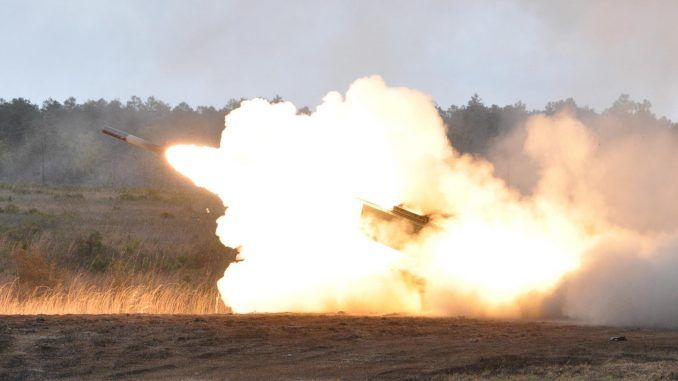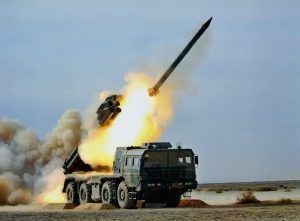
The United States has deployed M142 High Mobility Artillery Rocket Systems (HIMARS) from Jordan to a U.S. base at Al-Tanf in southeast Syria.
According to the Russian military, US-coalition forces have no need for long-range rocket launchers to fight ISIS with. Syrian government forces backed by Iranian affiliated militia have already cut off Daesh in the area.
The move sets the ground for a direct confrontation between the U.S. and the sovereign government of Syria, which is supported in its fight against the Islamic State by Iran and Russia.

BYPASS THE CENSORS
Sign up to get unfiltered news delivered straight to your inbox.
You can unsubscribe any time. By subscribing you agree to our Terms of Use
The U.S. military has moved a truck-mounted, long-range rocket launcher from Jordan to a U.S. base in Al-Tanf, Syria, near the Iraqi and Jordanian borders, according to two regional intelligence sources.
Reuters reports that the sources said the U.S. had moved the so-called High Mobility Artillery Rocket Systems (HIMARS) into the desert garrison, which has seen a buildup in recent weeks as tensions have continued to mount between U.S.-backed forces and Iranian-backed forces, as Anti-Media has previously reported.
“They have arrived now in Tanf and they are a significant boost to the U.S. military presence there,” one senior intelligence source reportedly said. The HIMARS has already been deployed in northern Syria as U.S.-backed forces have battled Islamic State militants, he added, Reuters reported.
The deployment comes barely days after Russia warned the U.S. not to strike Syrian-aligned troops again following multiple U.S. strikes last week.
As Reuters explains, the Al-Tanf border crossing is a vitally strategic area, which is why the U.S. military is continuing to cement itself firmly on the ground:
“Tanf is near a Syria-Iraq border crossing on the main Baghdad-Damascus highway. The rebels took it from Islamic State last year, partly to stop Iran from using it to send arms to the Syrian government.”
It is for this reason that the U.S. military has struck these Iranian-backed troops on multiple occasions, dangerously escalating the conflict by shooting down a Syrian drone barely a week ago, as well.
However, as Reuters explains further, there is one other strategic location in mind for the U.S. military that is heavily interlinked with Al-Tanf:
“The rebels also want to use it to take more territory along the border and to push toward Deir al-Zor, a large city on the Euphrates where the government has an enclave surrounded by Islamic State fighters.”
As Anti-Media reported earlier this week, video footage has emerged of hundreds of ISIS fighters safely fleeing Raqqa in convoys. It has been speculated that this safe passage is being allowed on purpose to allow these ISIS fighters to put further pressure on the Syrian government, a behind-closed-doors policy of the Obama administration (and now, perhaps, of the Trump administration). It is more than likely that these fighters will head towards Deir ez-Zor, where the Syrian government retains an isolated outpost surrounded by ISIS fighters (this has happened in the past).
Further, the U.S. military previously bombarded Syrian troops battling ISIS fighters in the Deiz ez-Zor region last year, further suggesting that the real aim of the U.S. military presence is to undermine Syria’s sovereignty and the Syrian government’s battle against extremist groups.
If Washington intends for U.S.-backed forces take control of both the Al-Tanf region and Deir ez-Zor, then it is becoming increasingly likely that the U.S. military is headed for a showdown with Iranian and Syrian troops given the strategic importance of these locations to the Syrian military and its allies. As the Washington Times notes:
“Military commanders in Damascus, Tehran and Moscow are setting their sights on the Syrian city of Deir el-Zour and the surrounding Middle Euphrates River Valley as the battleground for the fight against the jihadi group, also known as ISIS or ISIL.
“Coalition commanders and Pentagon officials say the overall battle plan will address the Islamic State buildup in Deir el-Zour. But with all eyes fixed on Raqqa, it remains to be seen how Syrian-led operations, backed by Russia, will affect that long-term strategy.”
While the deployment of this long-range rocket launcher may ultimately serve as a deterrent strategy towards Iranian-backed militias, it still forces the question of why an invading force should be allowed to deter the host country’s forces from reclaiming areas that legally belong to them in the first place. This is a clear violation of international law, otherwise, any country could do the same to the United States or its allies without so much as a blink from the U.N.
Technically speaking, the Syrian military is well within its rights to confront any invading force on its territory. However, doing so may unleash a large and unpredictable conflict that could redefine the future of humanity. While the media cheers on the American-led push to retake Raqqa from ISIS and ignores the reality of the conflict on the ground (as well as the mounting civilian death toll), we are getting closer to a global confrontation.

Edmondo Burr
CEO
Assistant Editor
Latest posts by Edmondo Burr (see all)
- Police Arrest Suspect In Supermarket Baby Food Poisoning - October 1, 2017
- Seoul Secures Data From Electromagnetic Interference By N Korea - September 30, 2017
- The ‘World’s First Internet War’ Has Begun: Julian Assange - September 30, 2017


Be the first to comment